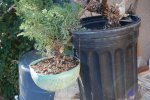bonhe
Masterpiece
MichaelS,
I think your climate is similar to mine. (hot dry summer, cool to cold wet winter?) Mild weather, not much frost.
I think so.
I graft (not just side but all kinds except thread and root) a lot in spring (late winter) but lately I have started to graft more in Autumn. (about mid March to early April here which would be mid September early October there)
Thank you.
My reasons:
1/ It gives you an opportunity to graft twice per year if you don't have much time in spring.
Make sense.
2/ With pines, I find I do not get the bad swelling at the graft union which I sometimes get in spring. (when I say spring I actually mean late winter here - about mid Feb to mid March in the US)
Very interesting! Thanks for noticing this phenomenon. I will have the answer for you soon (I have been trying to do presentation with Windows paint program!!!)
Thanks for noticing this phenomenon. I will have the answer for you soon (I have been trying to do presentation with Windows paint program!!!)
3/ By grafting in autumn, the scion has a long time to unite with the stock before the pressure of growing (increasing heat and light) forces it into growth.
In other words it will form a nice firm, fully healed union and but then remain dormant until spring when it takes off at the same time as the rest of the tree.
Thank you for letting us know.
It works very well on Conifers but also on deciduous.
Excellent!
With tropical evergreens like citrus, I like to do them when it's still quite warm. Even mid summer if you can protect them properly.
I agree.
Also, I noticed in your last pic that all the leaves of the stock has been cut off!
No, I did not cut all the stock needles off. I still leave those in the ends of the branches.
Normally with conifers the stock is cut back in many stages - slowly reducing the front of the branch until the scion is very well established. With a small scion on a heavy branch, this should take up to three years before the graft replaces the original!
I agree with you 101%. I have been reducing the stock needles for this tree at least 3 times already. Those small scions were recently just showed the elongated buds and that time the plastic bags were removed. With this tree, I am expecting that I can completely cut off the stock needles in few months. It means it takes about 18 months since the grafting time! You said it should take up to 3 years! The difference of the time maybe due to the way we control the auxin production of the tree differently.
Bonhe
I think your climate is similar to mine. (hot dry summer, cool to cold wet winter?) Mild weather, not much frost.
I think so.
I graft (not just side but all kinds except thread and root) a lot in spring (late winter) but lately I have started to graft more in Autumn. (about mid March to early April here which would be mid September early October there)
Thank you.
My reasons:
1/ It gives you an opportunity to graft twice per year if you don't have much time in spring.
Make sense.
2/ With pines, I find I do not get the bad swelling at the graft union which I sometimes get in spring. (when I say spring I actually mean late winter here - about mid Feb to mid March in the US)
Very interesting!
3/ By grafting in autumn, the scion has a long time to unite with the stock before the pressure of growing (increasing heat and light) forces it into growth.
In other words it will form a nice firm, fully healed union and but then remain dormant until spring when it takes off at the same time as the rest of the tree.
Thank you for letting us know.
It works very well on Conifers but also on deciduous.
Excellent!
With tropical evergreens like citrus, I like to do them when it's still quite warm. Even mid summer if you can protect them properly.
I agree.
Also, I noticed in your last pic that all the leaves of the stock has been cut off!
No, I did not cut all the stock needles off. I still leave those in the ends of the branches.
Normally with conifers the stock is cut back in many stages - slowly reducing the front of the branch until the scion is very well established. With a small scion on a heavy branch, this should take up to three years before the graft replaces the original!
I agree with you 101%. I have been reducing the stock needles for this tree at least 3 times already. Those small scions were recently just showed the elongated buds and that time the plastic bags were removed. With this tree, I am expecting that I can completely cut off the stock needles in few months. It means it takes about 18 months since the grafting time! You said it should take up to 3 years! The difference of the time maybe due to the way we control the auxin production of the tree differently.
Bonhe



























